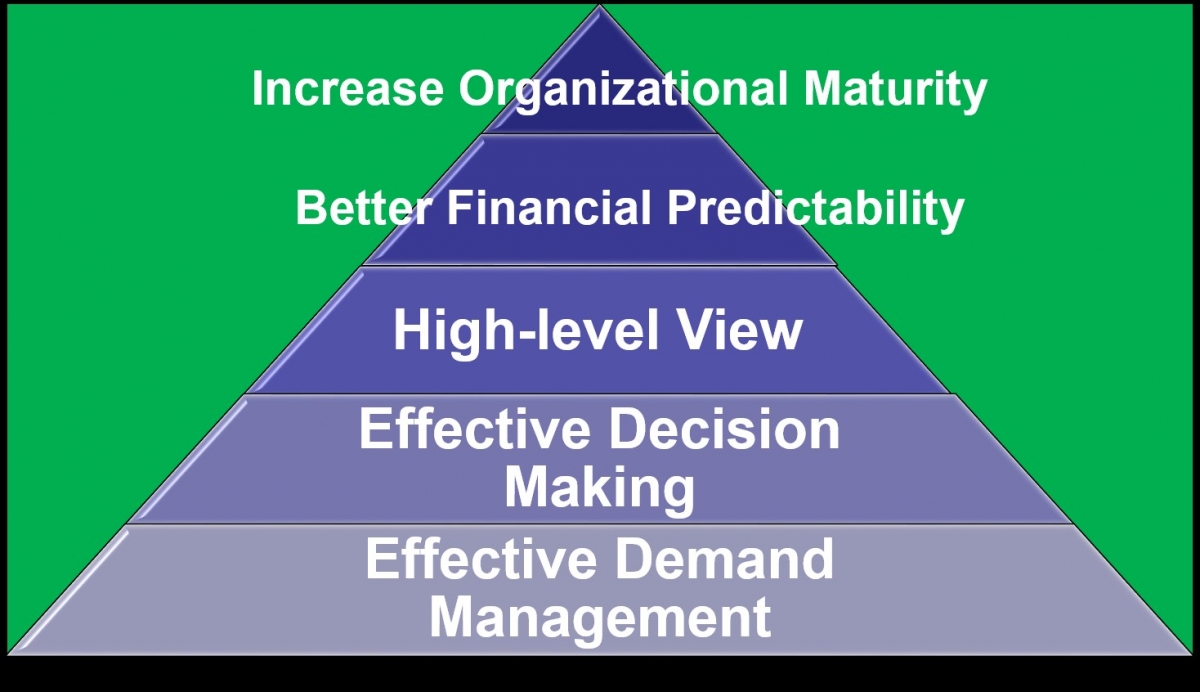In my previous blog, I had outlined the 4 major challenges faced by the organizations in their PPM (Project Portfolio Management) implementation . In my current blog, I will briefly discuss the underlying reasons behind the emerging need for PPM implementation.
Project Portfolio Management is getting recognition more so in the last 5-10 years. The overarching need for PPM implementation is realized by organizations primarily to align their strategic and business objectives. Organizations also realize that effective management of portfolio enables them to make effective decisions, manage resource and budget demands and also boost their financial predictability. The research performed helped understand the need for PPM implementation. The research results has been formulated into “PPM Hierarchy of Needs“(inspired from Abraham Maslow’s Hierarchy of Needs).
“The PPM Hierarchy of Needs suggests that organizations implement PPM in order to fulfill their multiple level of needs and once the basic level of need is satisfied, organizations seek to fulfill the next level of need.”
PPM HIERARCHY OF NEEDS

Level 1 – Effective Demand Management
Most of the times organizations have too many projects competing for very few budgetary and human resources. In such cases, the projects go out of control without enough resources for execution. On the contrary, there may be enough resources and plenty of opportuny for business growth, but no skilled resource which results in unsatisfied customers. Thus arises a need for effective demand management. Also there is a need to avoid one area of the organization which has a high demand from consuming large portions of budget or resources. All of these factors trigger the organization’s need to manage the demand for resources and budget effectively.
Level 2 – Effective Decision Making
Sometimes organizations have no real business case or rationale for the selection of projects. There is an absence of a cohesive plan for selecting a project over another. Instead of decision-making based on heuristics, advocacy (or) politics organizations need to focus more on structured ways of decision-making. Unstructured decision-making consumes a lot of time and is heavily biased. Hence, arises the organization’s indispensable need to establish effective project selection criteria and decision-making process.
Level 3 – High-level View
With the increasing global presence of organizations, there emerges a need for them to manage all their projects in a unified way. A PPM implementation gives an enterprises a global view of all of their on-going and pipeline projects. This helps them consolidate their long term vision.
An effective PPM implementation enables the organization to know what their resources are working on and what the status of proposed or on-going projects is. It also enables them to get information on the requested, committed, and available resources at any given point of time. Also, the high level view enables them to get a good picture of the overall opportunities and hence aids in decision-making.
Level 4 – Increase Organizational Maturity
Organization maturity reflects the way in which an organization functions. More mature the organization, more mature and effective are their practices and process. Hence, the organizations are always striving to get better at their organizational maturity. The need for PPM is felt to make the execution of strategies more leading edge and to increase the maturity of the organization. A matured organization has it s business strategy aligned with the selection and execution projects.
Level 5 – Better Financial Predictability
The need for PPM is felt by many organizations to better manage the financials of the project and avoid losing opportunity. Also, when organizations decide to cut-down their expenditure significantly there arises a need to preserve things that are of top priority to them. The thrust here is that when an organization runs out of money or resources, this will trigger the need to do more in-depth analysis for which they need an effective PPM implementation. In a market boom period, when there is typically a lot of money and resources, these issues are not very likely to surface, but there will be a need to be able to predict when the organization will have funds.
The above needs are explained on a very high-level. Hope you all got a gist of the reasons behind the critical need for PPM implementation in an organization. In my next blog I will talk about the mechanics for implementing PPM.
Interested in how EPMA can help you with your project schedules? Looking for a PPM Tool? Does your company want a PMO? Contact us today at 1.888.444.EPMA or [email protected].
For more details & kick start your project management journey, sign up for our Microsoft Training Classes or send us an email.
I hope you find this blog post helpful. For more tips and tricks on Project Management, please visit www.epmainc.com

